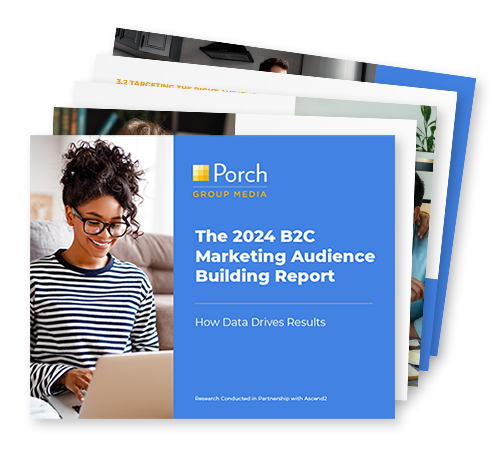Data is the cornerstone of an effective marketing strategy. In fact, an incredible 64% of marketing executives “strongly agree” that data-driven marketing is crucial in today’s landscape.
So, how can you leverage data effectively to achieve better marketing results? Invest in data-driven marketing.
What is Data-Driven Marketing?
Data-driven marketing relies on data and analytics to inform and optimize your marketing strategies and decision-making processes. It collects and analyzes data from multiple sources, including website analytics, customer relationship management (CRM) systems, social media platforms, and third-party data providers. This data encompasses insights, like demographics, behaviors, interactions, purchase history, engagement metrics, and more.
Leveraging these insights provides a complete view of your customers’ behaviors, preferences, and trends. This data can then be used to segment audiences, personalize marketing messages, target specific customer segments, and optimize marketing campaigns.
Benefits of Data-Driven Marketing
Better Decision-Making
Data-driven insights give you a deeper understanding of your customers, market dynamics, and competitive landscape. This enables more informed decision-making across all aspects of your marketing, from campaign planning and resource allocation to product development and pricing strategies.
Enhanced Targeting and Personalization
Understanding customer preferences and behaviors allows you to segment your audience and deliver personalized messages that resonate with individual customers.
Better ROI and Reduced Marketing Waste
By focusing resources on channels and tactics that deliver the best results, you can maximize the impact of your marketing investments while minimizing waste.
Increased Engagement and Conversion Rates
Personalized marketing helps capture attention and prompts your customers to take action, resulting in higher engagement and conversion rates.
Enhanced Customer Experiences
Personalization significantly enhances the overall customer experience. Delivering personalized content helps you drive more meaningful customer interactions that foster loyalty and satisfaction.
5 Ways to Power Your Data-Driven Marketing
1. Invest in First-Party Data Collection
88% of marketers claim first-party data is more important to organizations than two years ago. First-party data refers to the information collected directly from your customers or audience through interactions with your brand, such as website visits, email sign-ups, or purchase history.
Implement strategies to gather, store, and leverage your first-party data effectively.
Tips for maximizing first-party data collection:
- Encourage customers to provide information through registration forms, surveys, or preference centers.
- Ensure compliance with data privacy regulations and obtain proper consent for data collection.
2. Get to Know Your Customers with All-Party Data
All-party data encompasses a broader range of data sources beyond first-party data, including second-party, third-party, and zero-party data sources.
Getting to know your customers with all-party data involves aggregating and analyzing data from multiple sources to gain a comprehensive understanding of your audience.
In addition to first-party data, an all-party data strategy involves:
Second-Party Data
Second-party data is obtained through an indirect customer relationship (compared to first-party data, which is a direct customer relationship). This type of data is information the brand didn’t collect but is often obtained by working with a trusted partner who shares audience insights in a mutually beneficial relationship. It may include activity on websites, apps, and social media, survey responses, and more.
Third-Party Data
Third-party data is collected by external sources unrelated to your organization. It is aggregated data that is purchased or acquired from data providers or data aggregators. Third-party data is collected from various sources, such as public records, surveys, or online behavior tracking. It provides a wide range of audience insights but may be less accurate or specific to your particular business.
Zero-Party Data
Similar to first-party data, zero-party data is obtained from a direct relationship with the customer and is collected with consent. Examples of zero-party data include communication preferences, product preferences, and customized account configurations. Zero-party data provides a high level of accuracy and reliability, especially when combined with first-party data insights.
3. Invest in Data Cleansing
Data cleansing, also known as data scrubbing or data hygiene, involves identifying and correcting errors, inconsistencies, and inaccuracies in your marketing database.
Investing in data cleansing is essential for maintaining the quality and accuracy of your data, ensuring that your marketing efforts are based on reliable information.
Tips for effective data cleansing:
- Conduct regular audits of your marketing database to identify duplicate, outdated, or incomplete records.
- Implement a data quality solution to automate data validation and data quality processes.
- Enrich data with additional information from trusted sources to fill in gaps or correct inaccuracies.
4. Integrate Data with a Customer Marketing Data Platform
A customer marketing data platform is a centralized system that allows you to collect, organize, and analyze data from multiple sources to deploy unified marketing journeys.
By integrating data from various channels and sources, you can establish a unified audience view, and easily track brand interactions.
Tips for integrating data with a Customer Marketing Data Platform:
- Identify your key data sources and determining the types of data you want to collect and analyze.
- Select a DMP that aligns with your business needs and provides robust features for data integration, data quality, segmentation, and activation.
- Integrating data from multiple sources such as CRM systems, email marketing platforms, and third-party data providers into your DMP.
5. Use Segmentation for Targeted Messaging
Segmentation involves dividing your audience into distinct groups based on shared characteristics or behaviors. Using segmentation allows you to deliver targeted and personalized messages that resonate with each segment’s specific interests and needs.
Tips for effective segmentation:
- Analyze your customer data to identify meaningful segmentation criteria, such as demographics, purchase history, or engagement level.
- Create detailed customer personas or profiles for each segment to better understand their preferences, motivations, and pain points.
- Tailor your marketing messages, offers, and content to address the unique needs and interests of each segment.
As technology continues to evolve and data becomes increasingly abundant, embracing data-driven marketing is becoming more of an imperative to succeed in an increasingly competitive marketplace.





